Some of the links in this post may be affiliate links.
Add a tropical flair to your home with an Alocasia. There are many gorgeous Alocasia types that you can grow in your home, and this post showcases 23 stunning varieties.
Alocasia species are native to sub-tropical Asia and Eastern Australia but have gained worldwide popularity for their sculptural and decorative foliage and form.
Alocasia plants require a fair bit of humidity (owing to its tropical rainforest origin), warm temperatures, and appropriate lighting to do well.
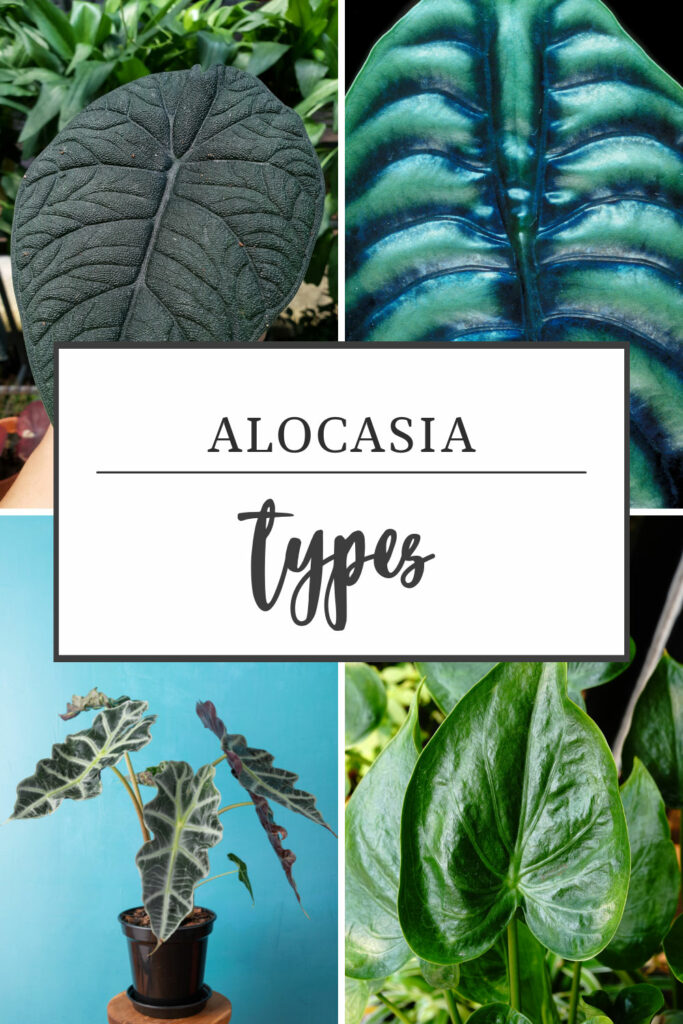
There are about 90 species of Alocasia, which vary in terms of the leaf shape, size, color contrasts and textures. Each of these types of Alocasia is beautiful and unique in its own way and works well as a living, breathing home décor.
Let’s look at some of the popular Alocasia varieties that you can add to your plant collection.
Table of Contents
23 Alocasia Types That Add Beauty to Your Home
1. Alocasia baginda ‘Silver Dragon’
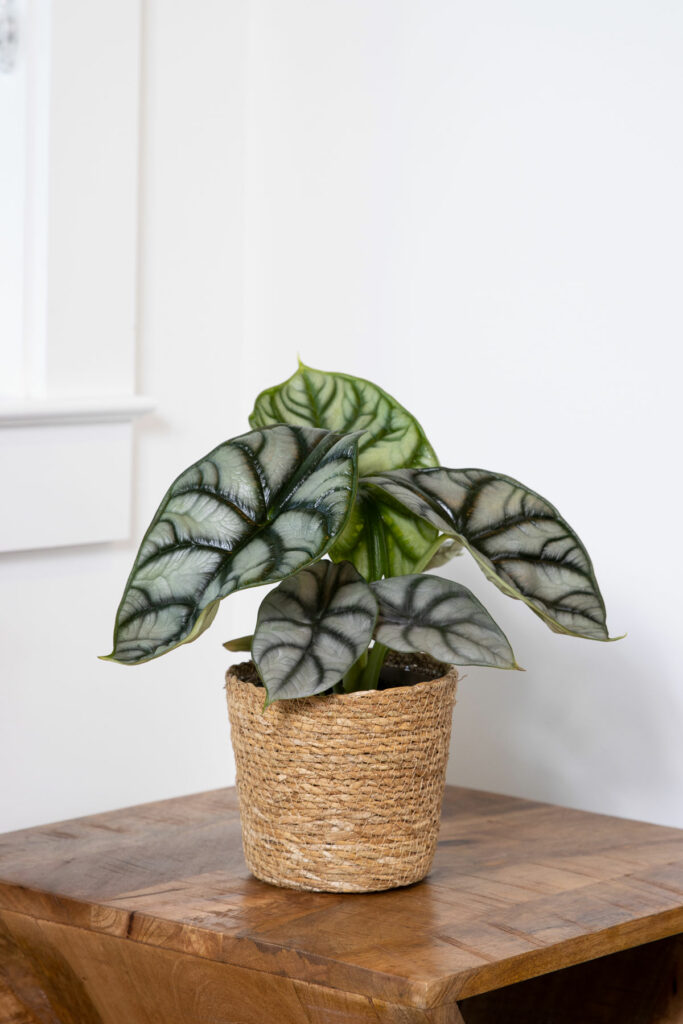
Alocasia baginda ‘Silver Dragon’ is one of the most rare and exotic varieties of Alocasia which is highly coveted for its unique foliage.
The plant gets the name ‘Silver Dragon’ from the dragon scale like patterns on the silver and green shield-shaped leaves. The leaves have dark green veins which offer a striking contrast with the greenish-silver tops.
Silver Dragons are not beginner-friendly and demand extra-attention from the plant parent to do well. Like many Alocasias, their growing conditions include bright, indirect light (indoors, an eastern or western exposure window would work well), well-drained soil, and consistently high humidity.
2. Alocasia cuprea ‘Red Secret’
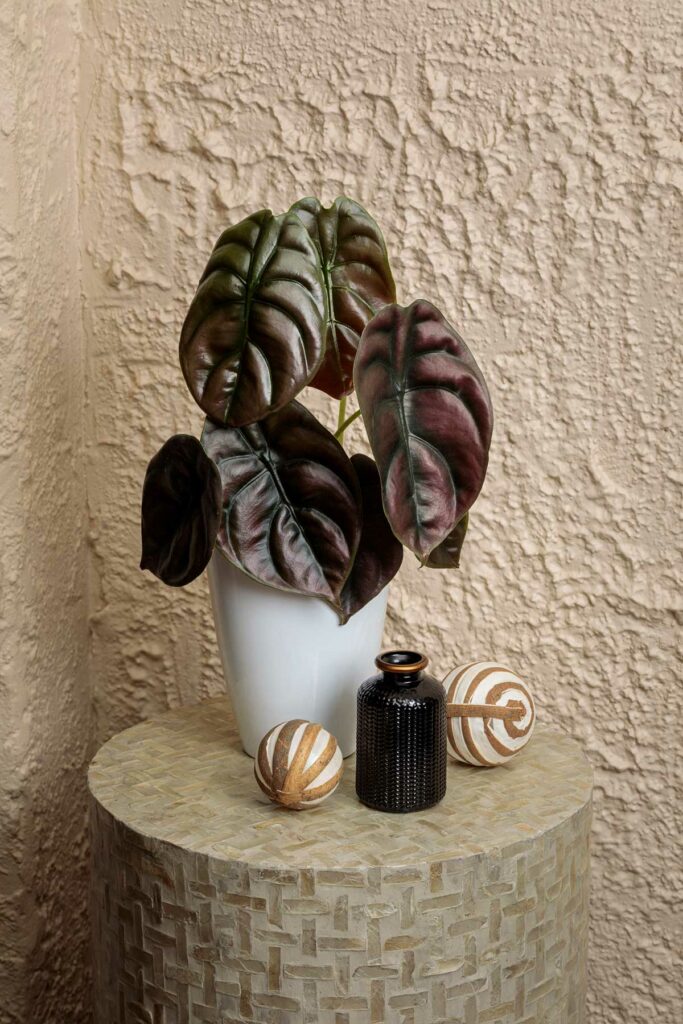
Alocasia cuprea ‘Red Secret’ is an extraordinary variety of Alocasia that is grown for its majestic foliage. It is also called the “Mirror Plant” because of its super glossy leaves which have a metallic shine and light-reflecting properties.
The deep ridges in the leaves lend a striking character and texture to the plant.
The plant can grow up to 1 meter (a little over 3 feet) tall in good conditions.
It will do well if you maintain 60% humidity levels at all times, use well-drained, aerated potting mix and place it in warm temperatures and keep it in front of an eastern or western facing window indoors.
3. Alocasia baginda ‘Pink Dragon’
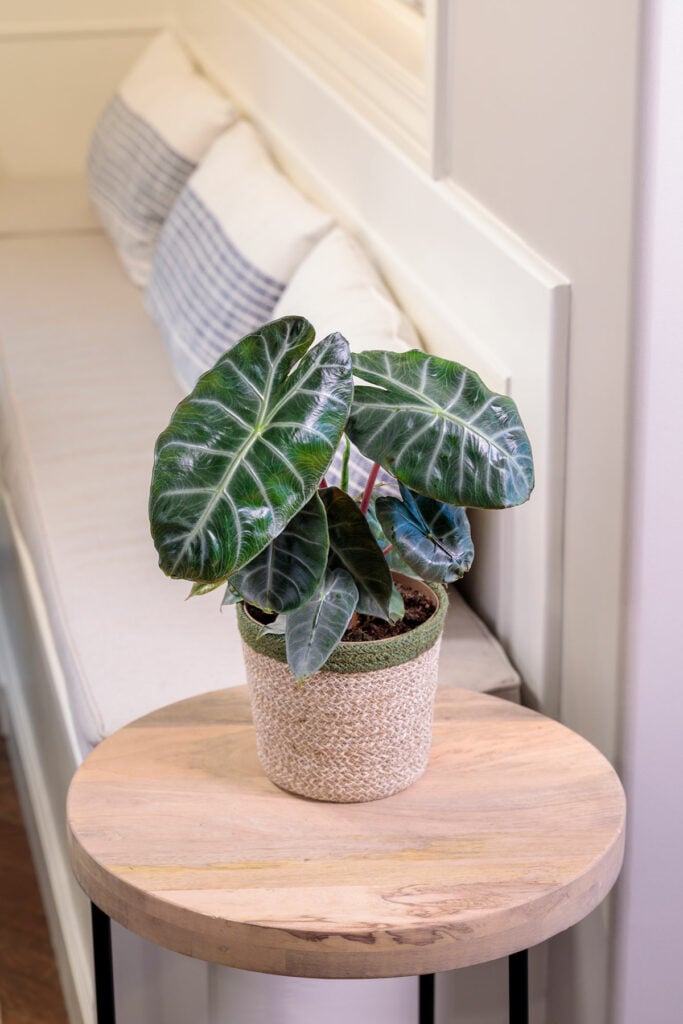
Alocasia baginda ‘Pink Dragon’ adds an element of beauty and drama to your space with a beautiful combo of metallic green foliage and characteristic pink petioles.
The leaves are heart-shaped with silver veins on the topside and dark pink hues on the undersides. The plant can grow up to 4 feet tall and bring jungle-like tropical vibes to your space.
‘Pink Dragon’ is a humidity loving plant which requires more than average indoor humidity levels to grow well. It works best in bathrooms and kitchens where the humidity levels are consistently maintained.
The plant prefers well-drained soil mix and an eastern or western exposure window indoors.
4. Alocasia reginula ‘Black Velvet’
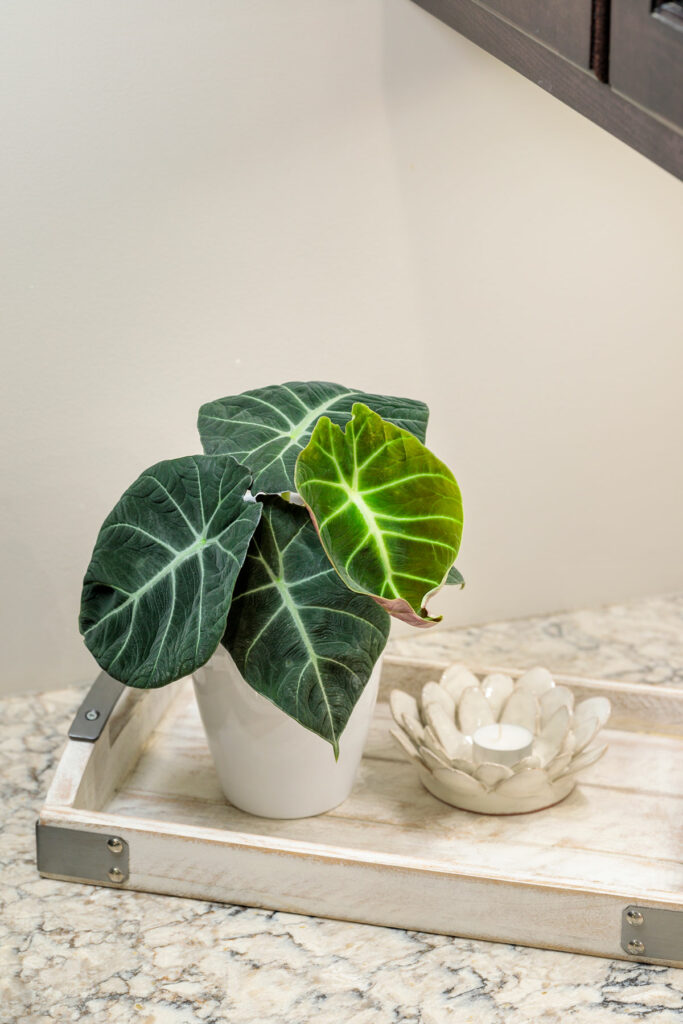
Alocasia reginula ‘Black Velvet’ adds an incredible ornamental value to your indoors with its beautiful foliage. The dark, velvety leaves are accentuated with silvery veins and lend a luxurious appearance.
‘Black Velvet’ is a relatively small variety of Alocasia, which works well in any space, including terrariums.
The plant doesn’t demand a lot of attention, except for basic Alocasia growing conditions.
5. Alocasia baginda ‘Dragon Scale’
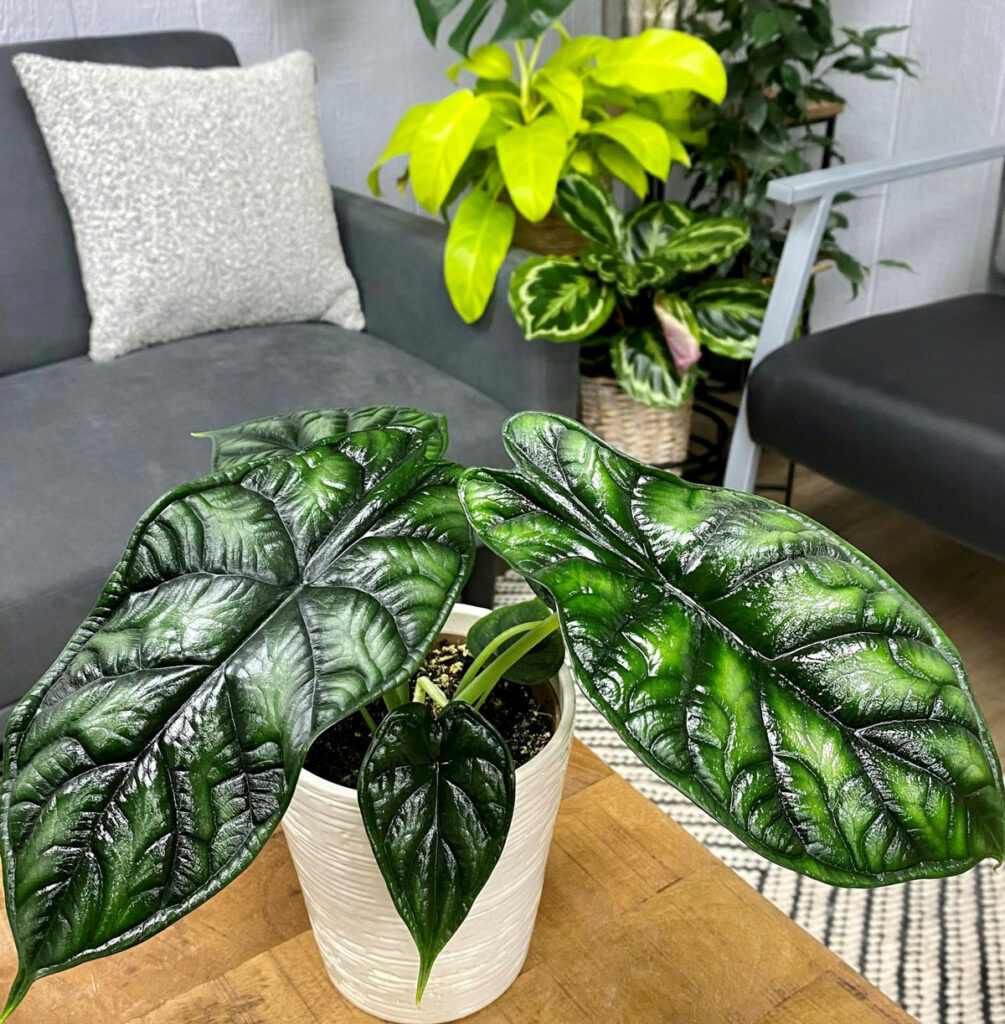
Alocasia baginda ‘Dragon Scale’ gets its name from the reptilian-like appearance of its dark green foliage. The leaves have prominent venation patterns with deep ridges that produce an embossed effect.
Mature leaves have a dark green hue with maroon veins on the underside.
Like any Alocasia, ‘Dragon Scale’ likes great drainage, and doesn’t like its potting mix to dry out completely. A humidity range of 60-80% will serve this plant well.
Cool temperatures can stunt the growth of the plant and trigger dormancy, so try and keep your plant at a minimum temperature of 60°F (approximately 15.5°C) or above.
6. Alocasia x amazonica ‘Bambino’
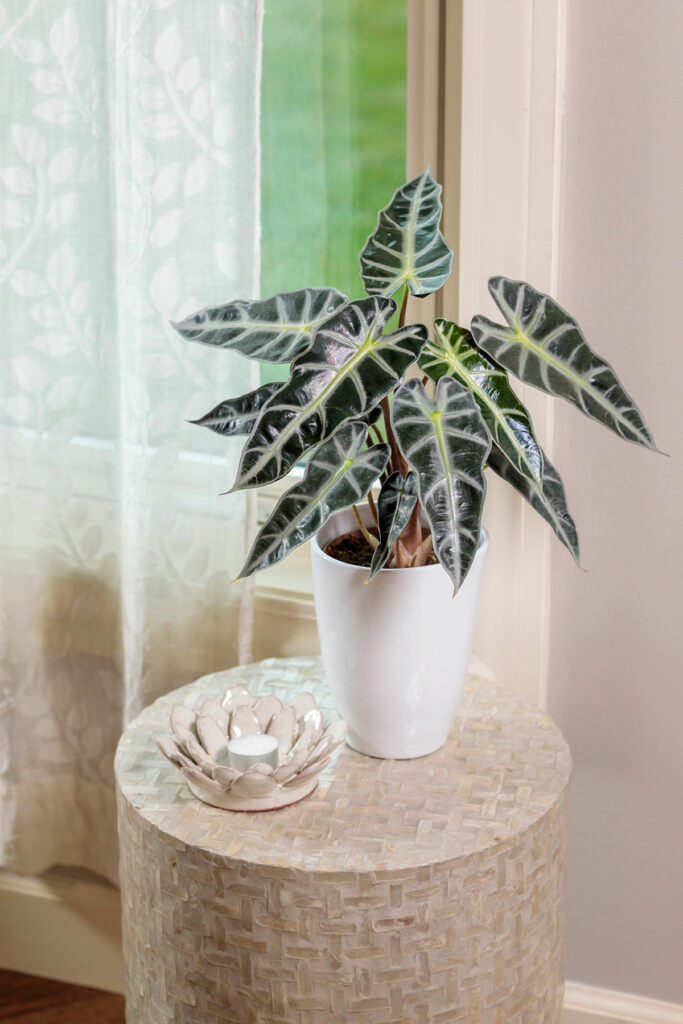
Alocasia amazonica ‘Bambino’ is a dwarf variety of Alocasia that reaches a maximum of 12 inches in height. It may be the smallest member in its family, but ticks all the boxes in the looks and maintenance departments.
The long leaves have beautiful wavy edges, adding a striking visual appeal to the plant. The prominent cream colored veins on the top, with purple undersides, offer a perfect color contrast to this beautiful houseplant.
Alocasia Bambino is easy to care for under the right conditions. They grow happily in indoor locations with high humidity levels in kitchens or bathrooms that have appropriate lighting.
Provide consistent growing conditions and clean the leaves regularly to enjoy its mesmerising beauty for years to come.
7. Alocasia reginula ‘Ninja’
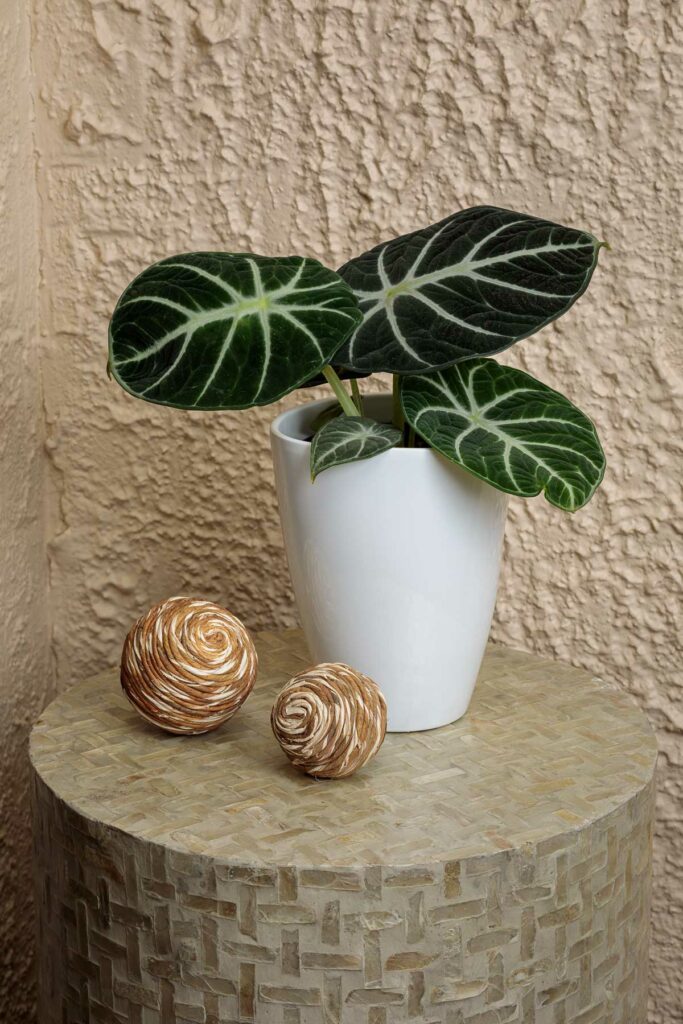
Many gardeners often mistake the Alocasia reginula ‘Ninja’ for the Alocasia ‘Black Velvet’, owing to the identical dark, velvety foliage.
There is an easy way to distinguish the ‘Ninja’ from ‘Black Velvet’ as the former has thick, embossed leaves with double marginal veins. The size of foliage is much larger and rounder with purple undersides.
These plants grow to a maximum height of 12 to 18 inches. Due to their petite size, Ninjas work well as decorative plants on desks and windowsills.
Give them the humidity they crave and an eastern or western exposure window to enjoy their spectacular, gothic beauty.
8. Alocasia melo
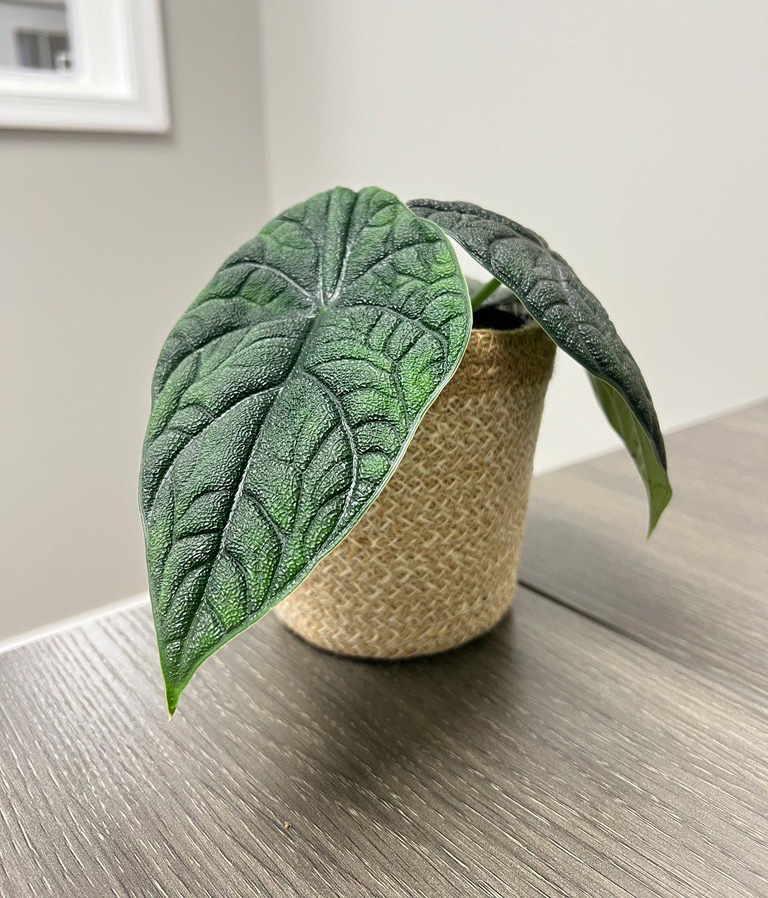
Introducing another variety of Alocasia plant that looks fake until you touch it physically.
Alocasia melo boasts of one of the thickest, sturdiest leaves in the Alocasia family, so there is little worry of you tearing them accidentally.
The jade green leaves mature into a slate grey color but maintain their rugged texture and pronounced venation.
Like any Alocasia, it prefers moist, well-drained soil with high humidity levels.
9. Alocasia nebula
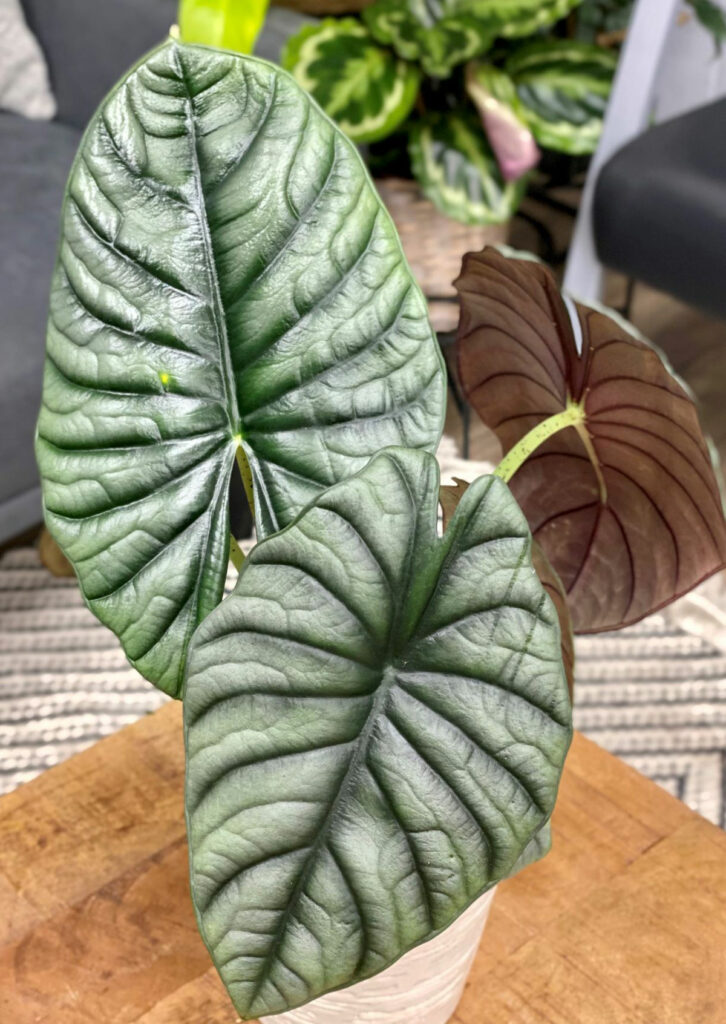
Alocasia nebula is a jewel variety of Alocasia which has heart-shaped leaves that have a silvery shade and point downwards.
Nebula is a tricky species which has precise growing needs like high humidity, consistently moistened soil and bright, indirect sunlight.
Keep the potting mix too wet, and the plant can develop root rot. Keep it too dry, and the plant will start to go dormant. Aim to allow the top inch or the potting mix to dry out and then water.
Once you strike a balance and familiarize yourself with its requirements, you will start loving this plant.
Like many Alocasia plants, be prepared to lose a few leaves during winter as the plant goes into a semi-dormant state, only to regrow new leaves in the spring. You can avoid this from happening by introducing grow lights when the days are getting shorter.
10. Alocasia azlanii
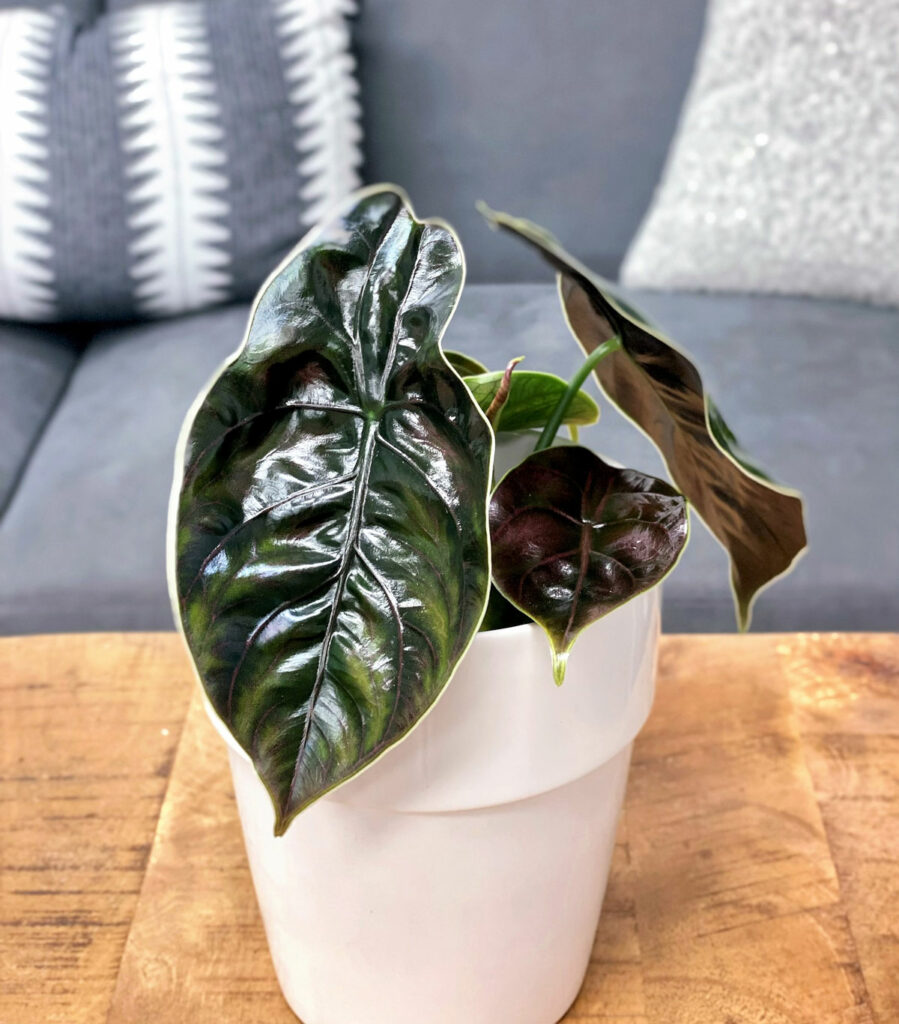
Alocasia azlanii also called the ‘Red Mambo’, and is a relatively new and rare variety of Alocasia that comes from the tropical forests of Borneo.
It is blessed with one of the most spectacular foliage in the Alocasia family, which can outshine the rest of the plants in your collection. The leaves have deep pinkish purple hue with a glossy, metallic texture that give the effect of a stained-glass finish.
This variety is not a plant-it-and-forget-it plant as it requires good amount of care and love.
It hates temperature changes (particularly cool temperatures) and is intolerant to “overwatering” and underwatering. Keep the plant happy with moist but not wet soil and a warm environment with high humidity levels.
11. Alocasia plumbea ‘Nigra’
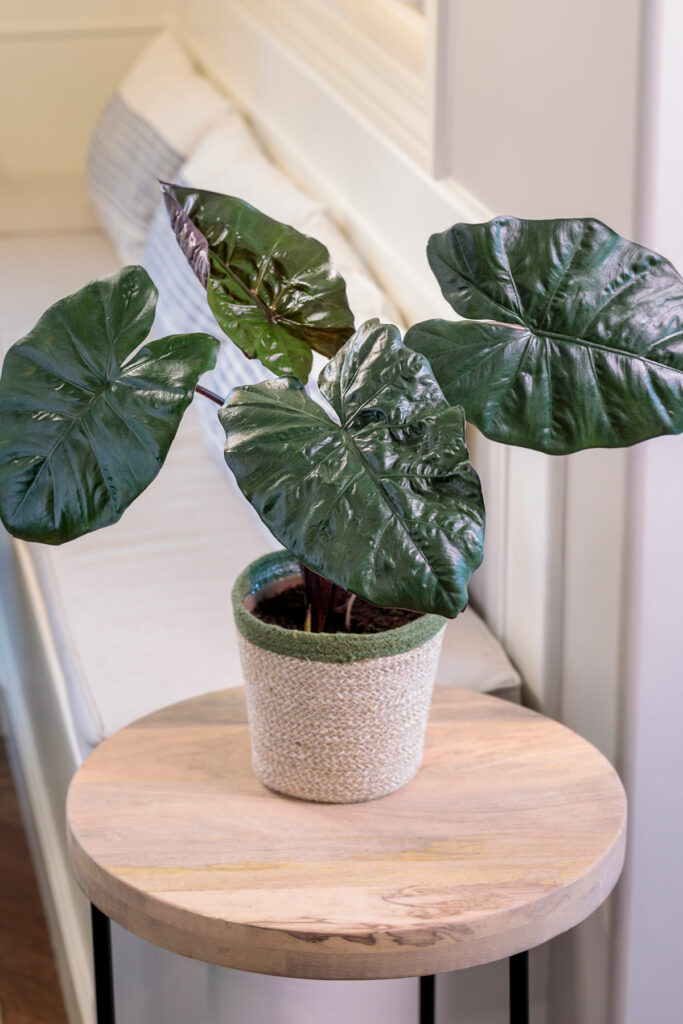
Alocasia plumbea ‘Nigra’ boasts one of the largest leaves in the Alocasia family. The stunning foliage is a deep burgundy color that almost appears black. It is also known as the ‘Black Metallic Taro’ owing to its glossy metallic surface of the leaves.
Alocasia Nigra can grow 3-5 feet tall depending on whether you grow it indoors or outdoors.
Typical Alocasia growing conditions will suit this plant well.
12. Alocasia ‘Portora’
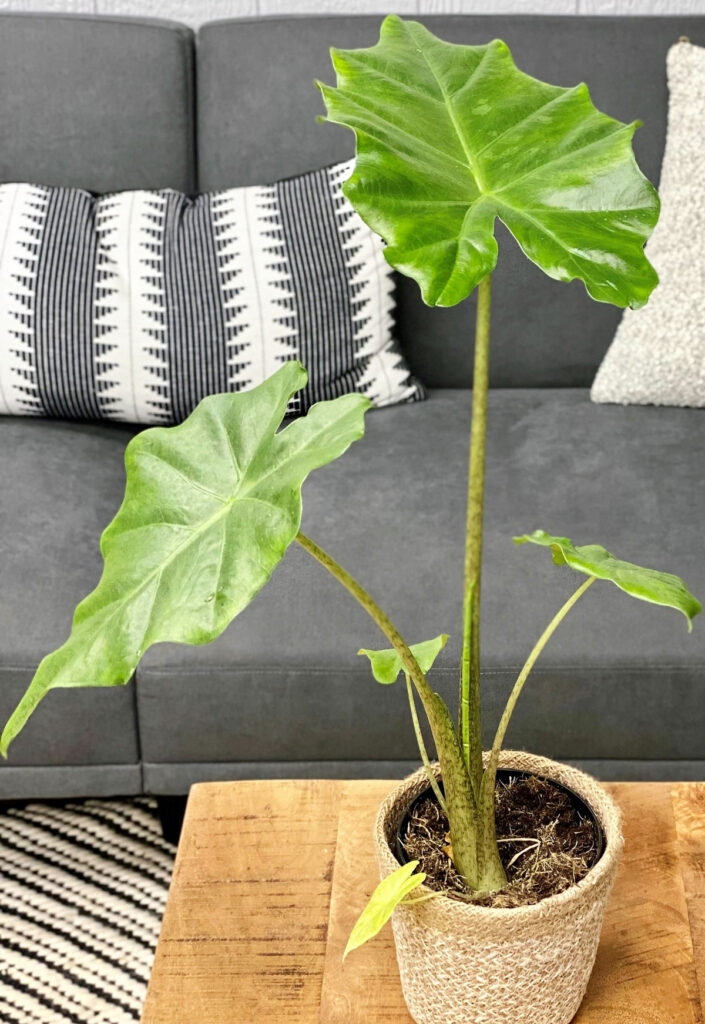
Alocasia ‘Portora’ truly lives up to its name Elephant Ear. The leaves have an impressive size, measuring up to 3 feet or so in length. The plant can grow around 5-6 feet tall, making for a wonderful choice as an architectural plant in your front or backyard.
It is also well suited as a houseplant.
Caring for Alocasia Portora couldn’t be easier as the plant is more drought-resistant than many Alocasias. It performs best though in full fun to partial shade with regular watering and nutrient-rich soils.
13. Alocasia ‘Regal Shields’
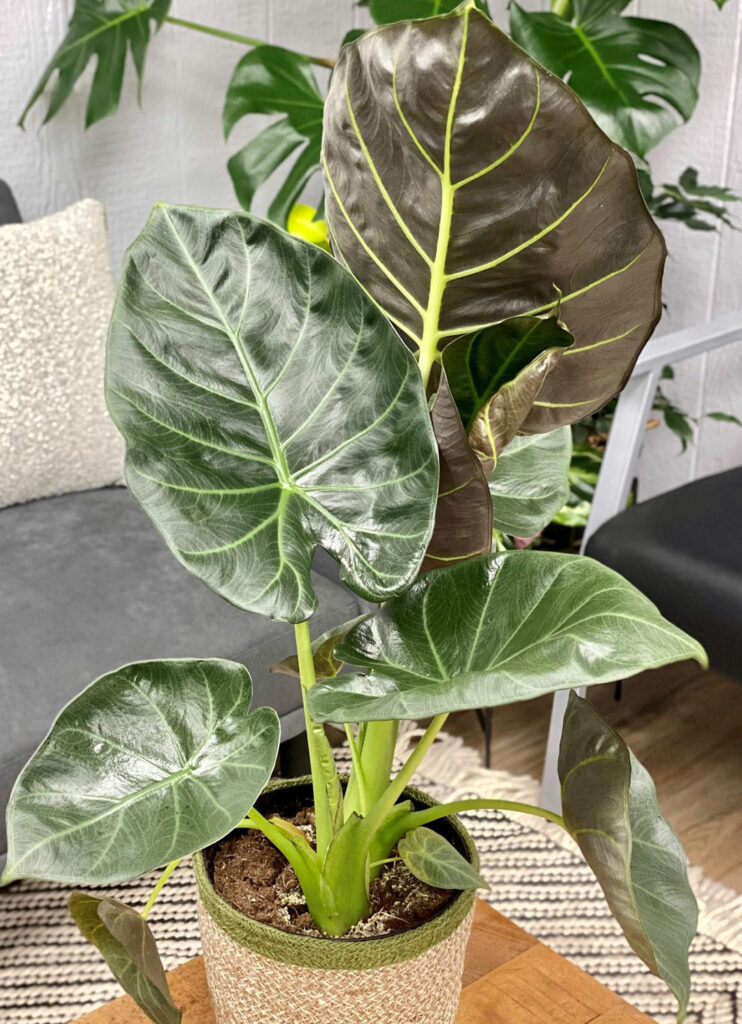
Alocasia ‘Regal Shields’ is a hybrid variety of Alocasia, best known for its gigantic leaf size. It has long petioles and deeply veined, greenish purple colored leaves that can spread around 1-1.5 m in length.
Many gardeners grow this variety for its sculptural beauty.
Regal shields can do well both indoors and outdoors if you maintain the right conditions. Outdoors, place the plant under dappled sunlight as direct afternoon sun can scorch its delicate leaves.
Indoors, it can take quite a bit of direct sun since light intensity indoors is much less than outdoors.
14. Alocasia macrorrhiza ‘Stingray’
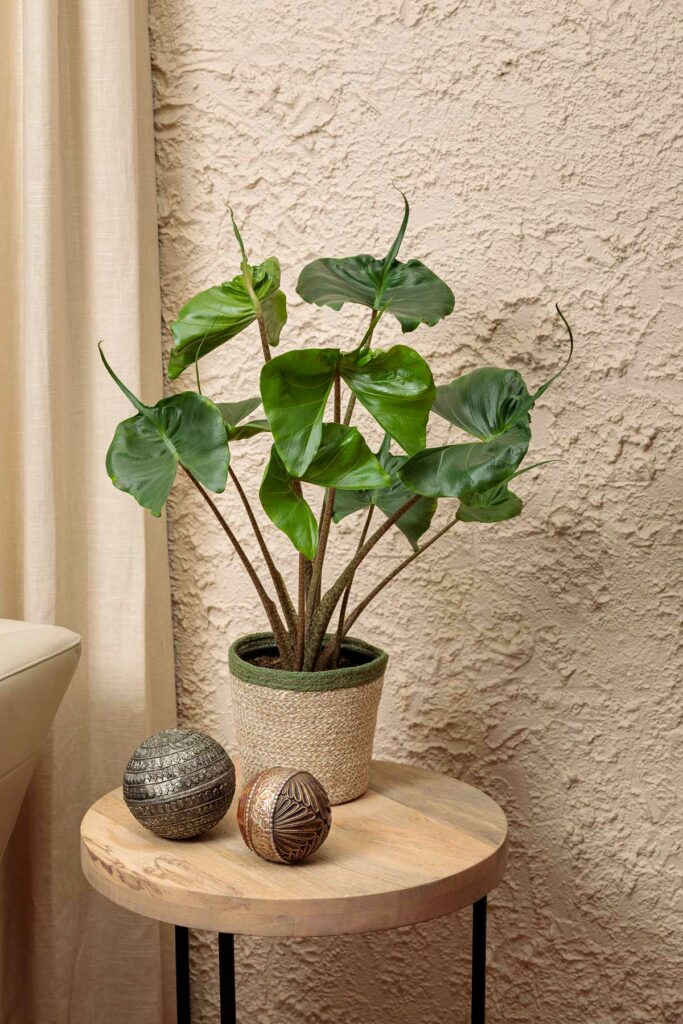
Alocasia macrorrhiza ‘Stingray’ is a variety of Alocasia which steals your attention with its unique beauty.
Looking at the plant, it’s not hard to understand the reason for the name ‘Stingray’. The leaves have a pointy tail that resembles the marine creature.
‘Stingray’ leaves have a rubbery appearance and emerald green color. They are humidity loving plants which prefer an eastern or western window indoors, with a moist, well-draining potted mix.
15. Alocasia ‘Frydek’
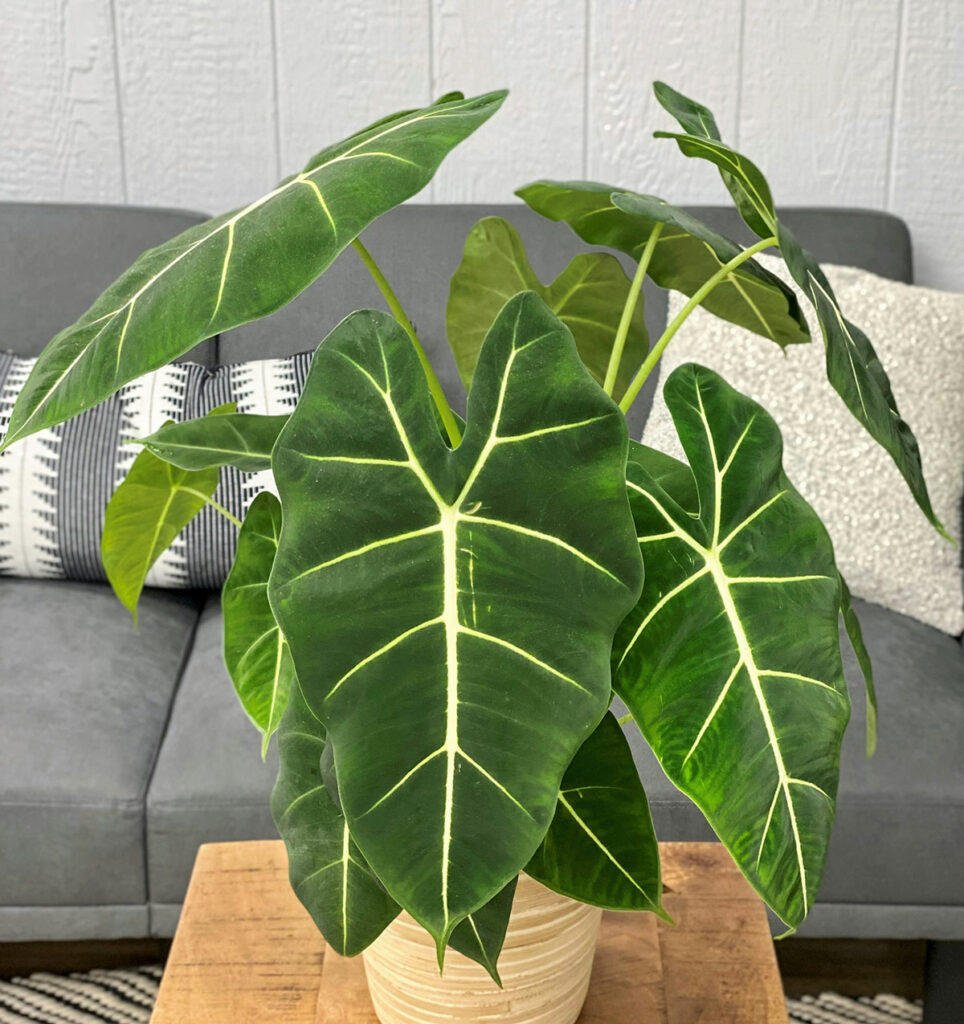
Alocasia ‘Frydek’ has the potential to become the ultimate masterpiece of your indoor garden. It is a gorgeous houseplant that resembles a plush toy with its super soft, velvety green foliage.
No wonder why many people call it the “Green Velvet” plant. Mature plants have dark green hues with contrasting cream colored veins.
Frydeks are relatively easy to grow. They love humidity and prefer an eastern or western exposure window, with warm temperatures and evenly moist potting mix.
They can be prone to pests like spider mites, especially in low humidity, so keep a close eye on the foliage.
16. Alocasia ‘Nairobi Nights’
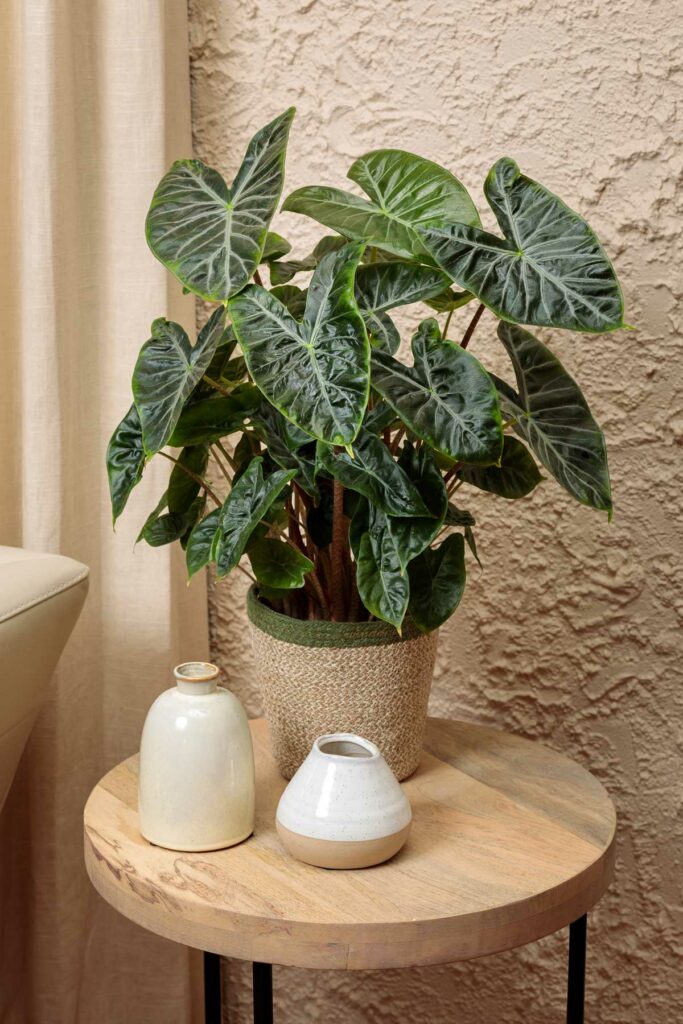
Alocasia Nairobi Night makes for a great addition to your indoor garden as it spells magic with its spectacular foliage.
The dark green, almost blackish leaves are contrasted well with the prominent white veins and pink petioles. As the plant matures, it will form into quite a striking specimen.
Nairobi Night loves conditions that are typical to most Alocasias: high humidity, evenly moist soil, and up to about half a day of direct sun indoors.
17. Alocasia ‘Sarian’
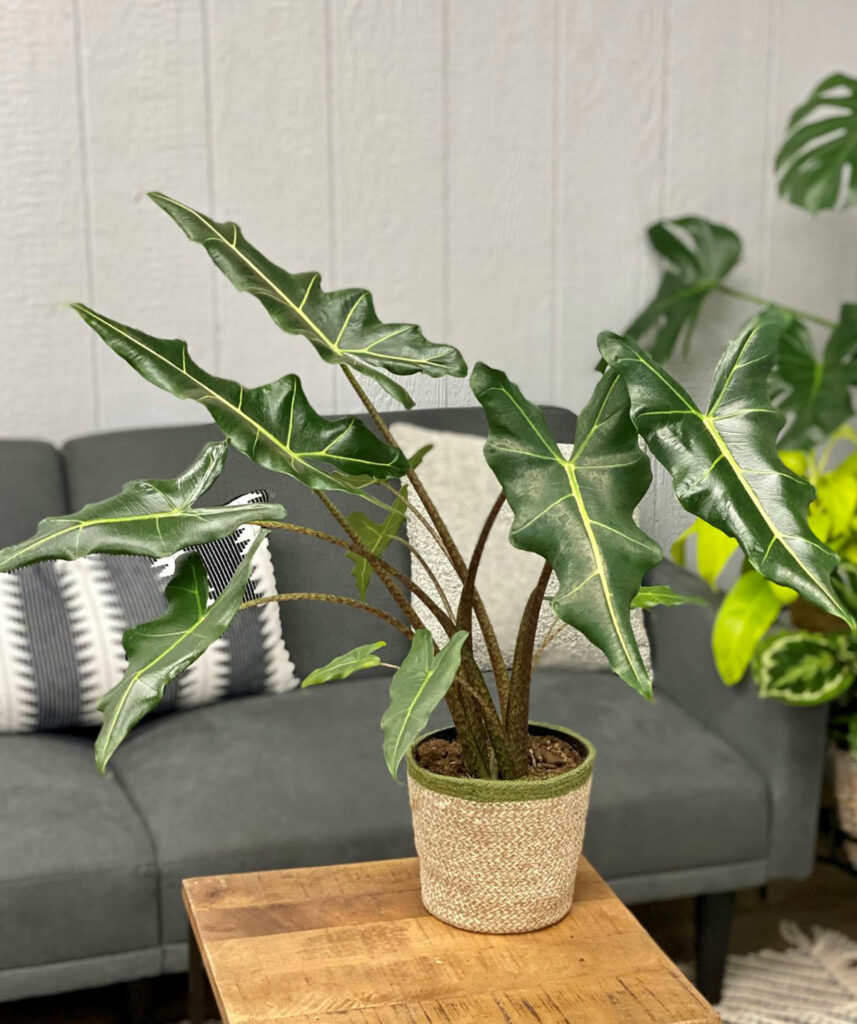
Alocasia ‘Sarian’ is one of the most impressive looking varieties of Alocasia and adds a bold, dramatic look to your home.
The leaves are long and pointed, reminding us of the ears of an African elephant. It’s also called the African mask as a result of its unique foliage with wavy edges.
Alocasia ‘Sarian’ prefers watering after you’ve allowed the top inch or two of soil to dry out. An eastern or western exposure window would be a great growing location for this plant.
18. Alocasia cucullata ‘Buddha’s Palm’
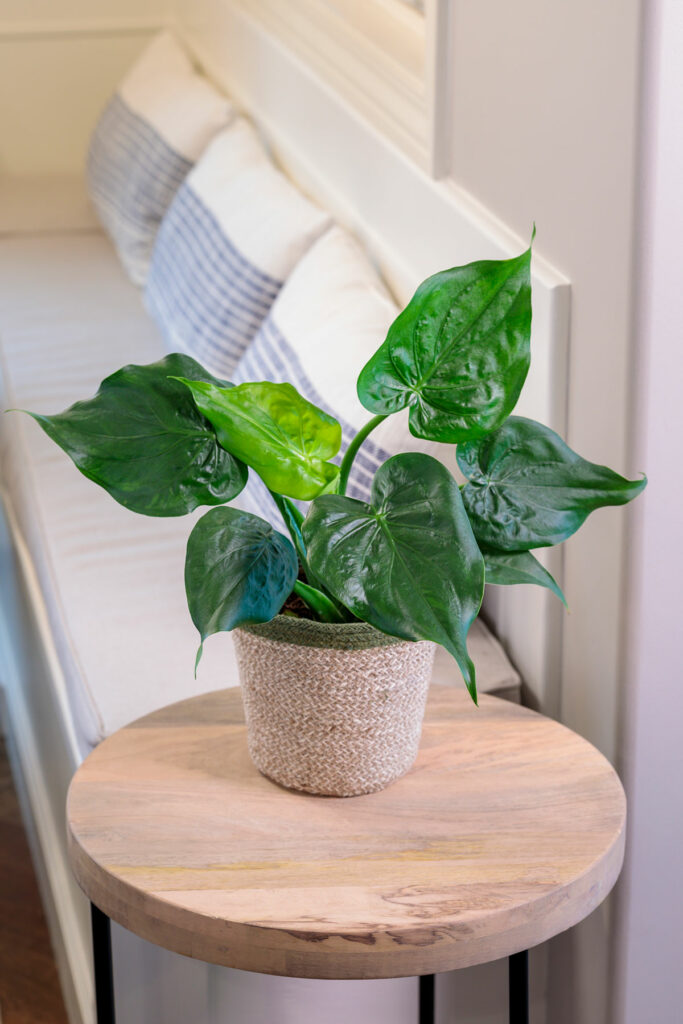
If you want to invite some good fortune to your home, Alocasia ‘Buddha’s Palm’ can be your ticket. The exotic variety of Alocasia is known to invite good luck and prosperity as the unique leaf shape resembles a Buddha’s palm.
The plant features slender petioles with large, pointy leaves that sway gently with the breeze, almost like Buddha giving his blessings.
Indoors, Buddha’s Palm prefers eastern or western exposure windows, with moist, well-draining soils. In winters, you can place the plant under a grow light to give it the warmth and light it craves.
19. Alocasia x amazonica ‘Ivory Coast’
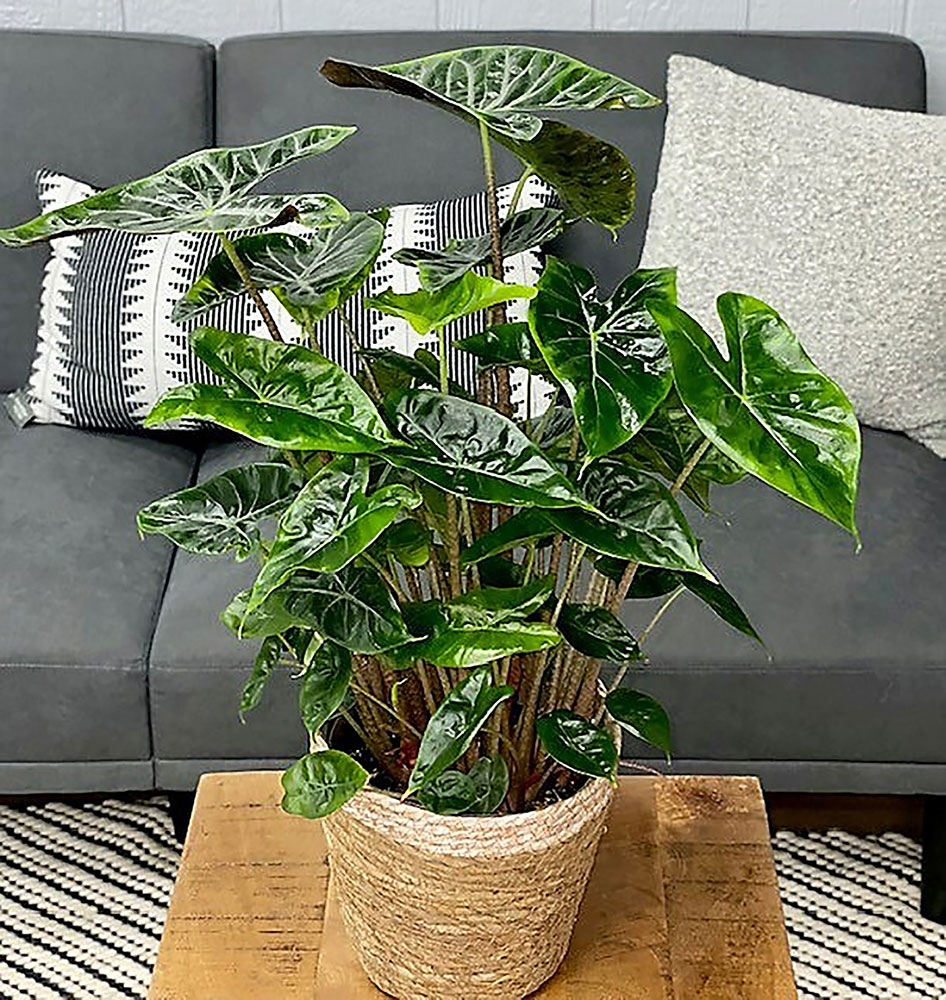
The ‘Ivory Coast’ is a hybrid variety of Alocasia amazonica which is quickly gaining popularity as a houseplant.
It has an impressive appearance with green, arrow-shaped leaves with silvery hued veins. The pinkish bornw petioles offer a perfect contrast to the leaves, reminding us of the Pink Dragon, another variety of the Alocasia family.
The best part about the ‘Ivory Coast’ is the tightly packed cluster of leaves which create a lush, full specimen under good care. The plant will do well when placed in an eastern or western exposure window, while maintaining a moist potting mix and consistently warm temperatures.
20. Alocasia wentii
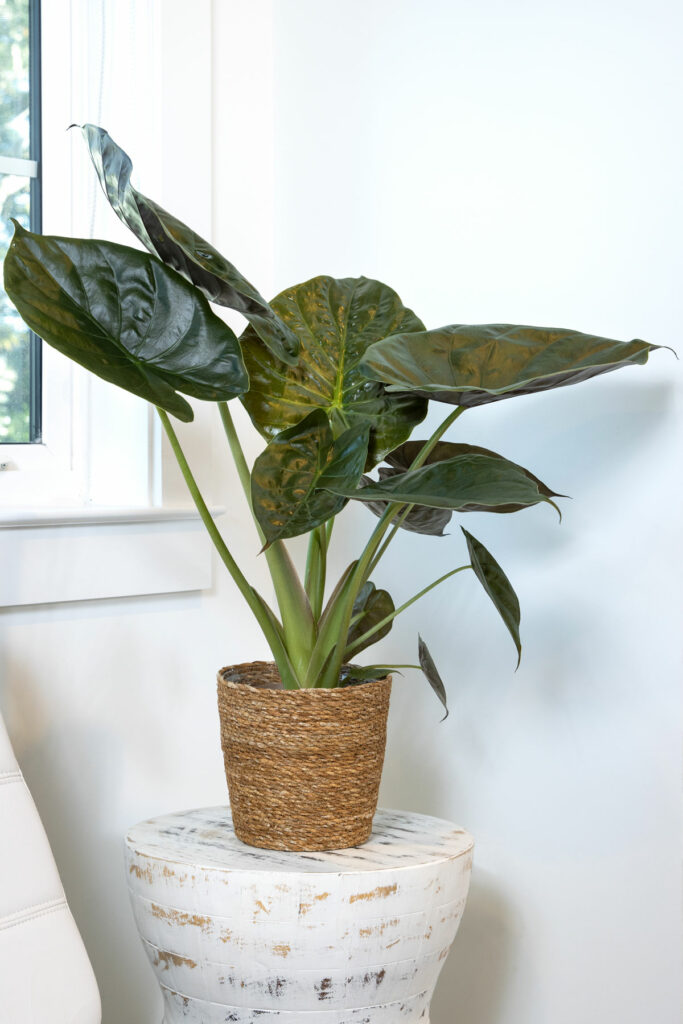
Alocasia wenti is a classic variety of Alocasia that is known for its easy-to-grow nature. You can identify a wenti from its glossy foliage with green topsides contrasted with purple hues underneath.
The large leaves typically grow around 30-40 cm long.
21. Alocasia longiloba
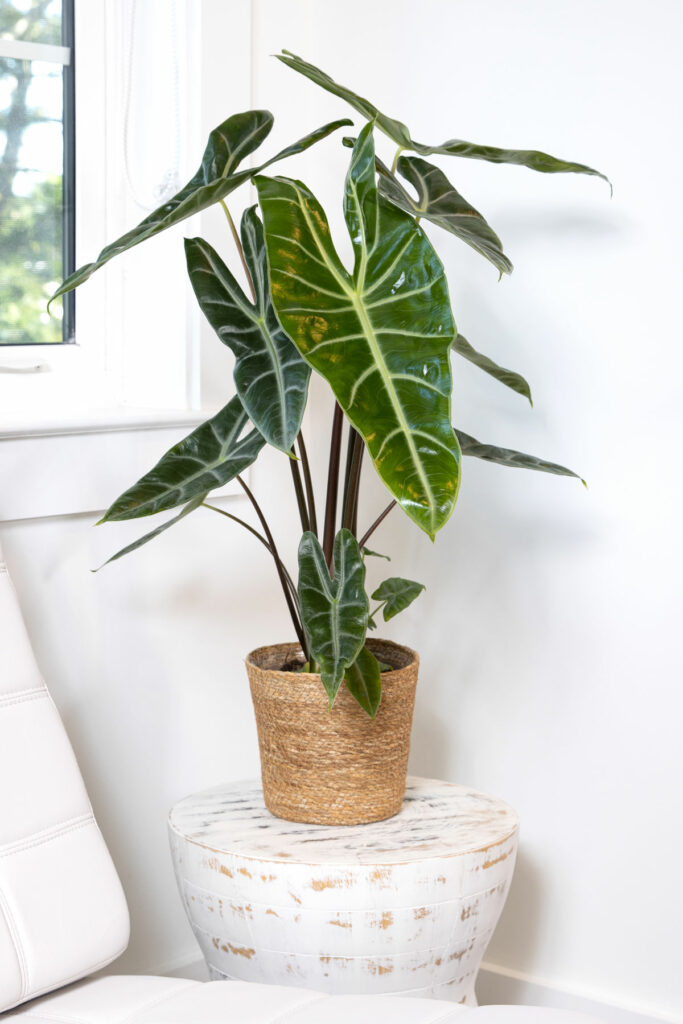
Alocasia longiloba has long, green leaves with prominent silver veins. Mature leaves can grow almost up to 2 feet in length, creating quite a statement in a well-grown specimen.
An evenly moist potting mix and high humidity levels are a must to keep this plant happy.
22. Alocasia lauterbachiana
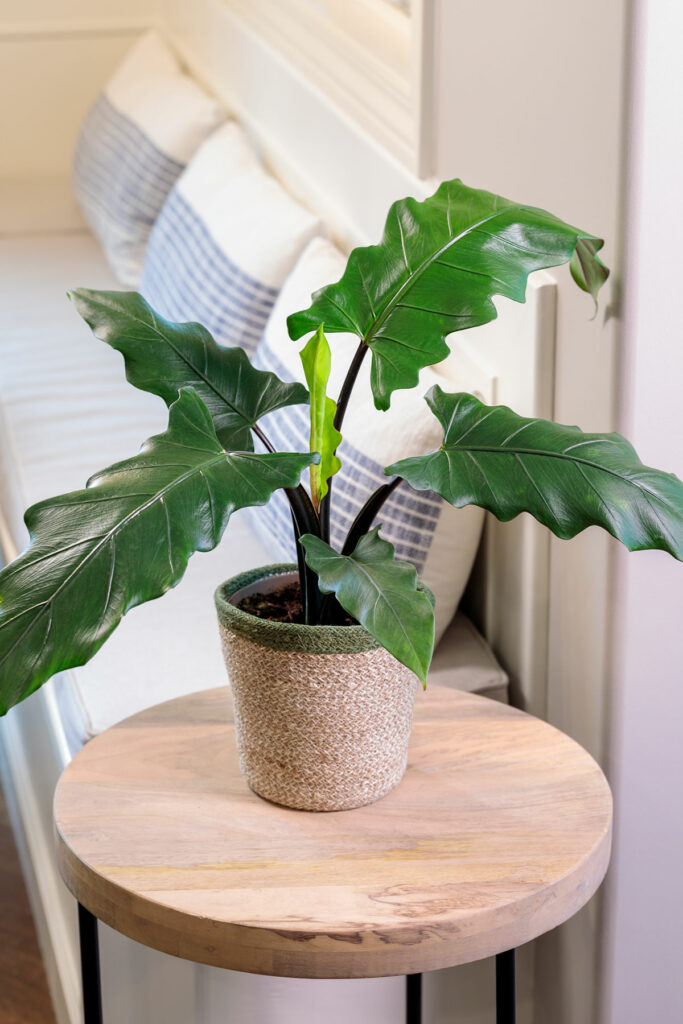
If you are seeking a one-of-a-kind variety of Alocasia, then the lauterbachiana is your plant. The sword shaped leaves are narrow and green with purple undersides.
No wonder why the lauterbachiana is commonly called the purple sword plant or sword leaf plant.
In optimum conditions, the plant can reach up to 4 feet tall or so, making a striking statement in your home.
23. Alocasia zebrina
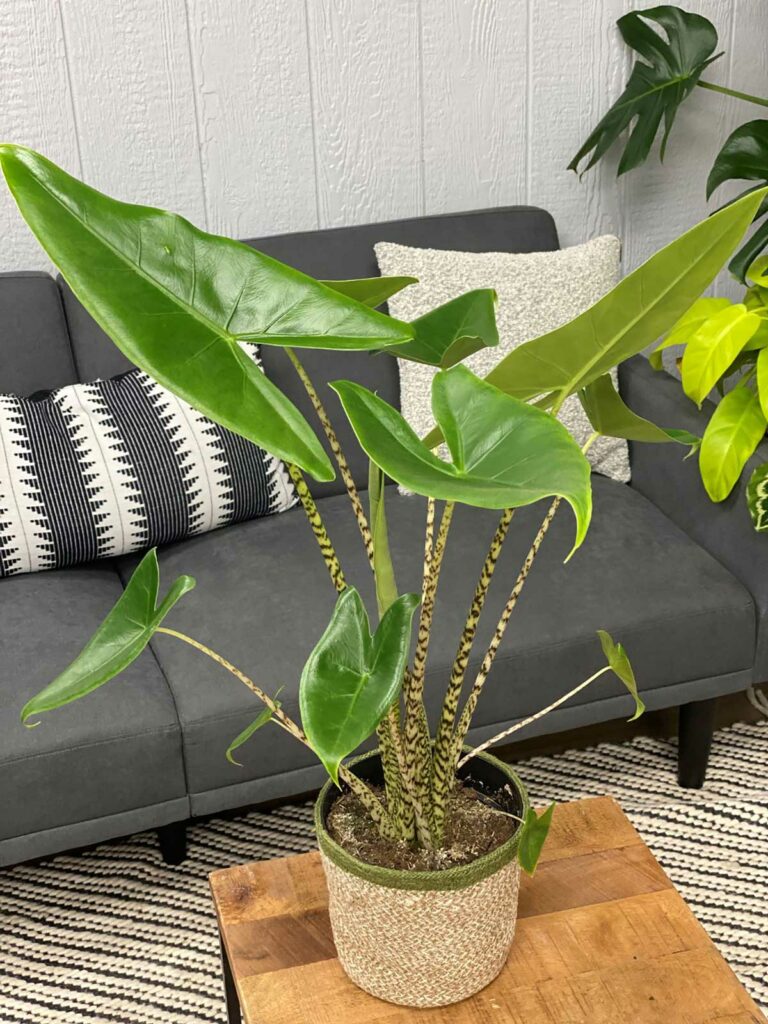
Observe the petioles of the Alocasia zebrina and you will know why it gets the name.
The speckled stems resemble Zebra like patterns which complement the elephant ear leaves beautifully.
Zebrinas are not very beginner-friendly and demand fair bit of attention from the growers. The easy way to grow them is by mimicking the natural conditions of the plant – think of a tropical rainforest-like environment.
With so many Alocasia types to choose from, it’s hard to pick just one! We would recommend trying out one or two varieties to understand the basic needs of the plant and slowly expand your collection.
With a little care and and understanding of growing conditions, your Alocasias will grow into a prized member of your indoor garden.
If you’ve enjoyed this post, be sure not to miss my post on Alocasia flowers. Many people have asked me about them, so I’ve written a post with the most common questions that my readers have.
Lastly, Alocasias can be prone to root rot, so check out my post on Alocasia root rot so you know how to prevent it, and don’t miss my post on best soil for Alocasia plants.

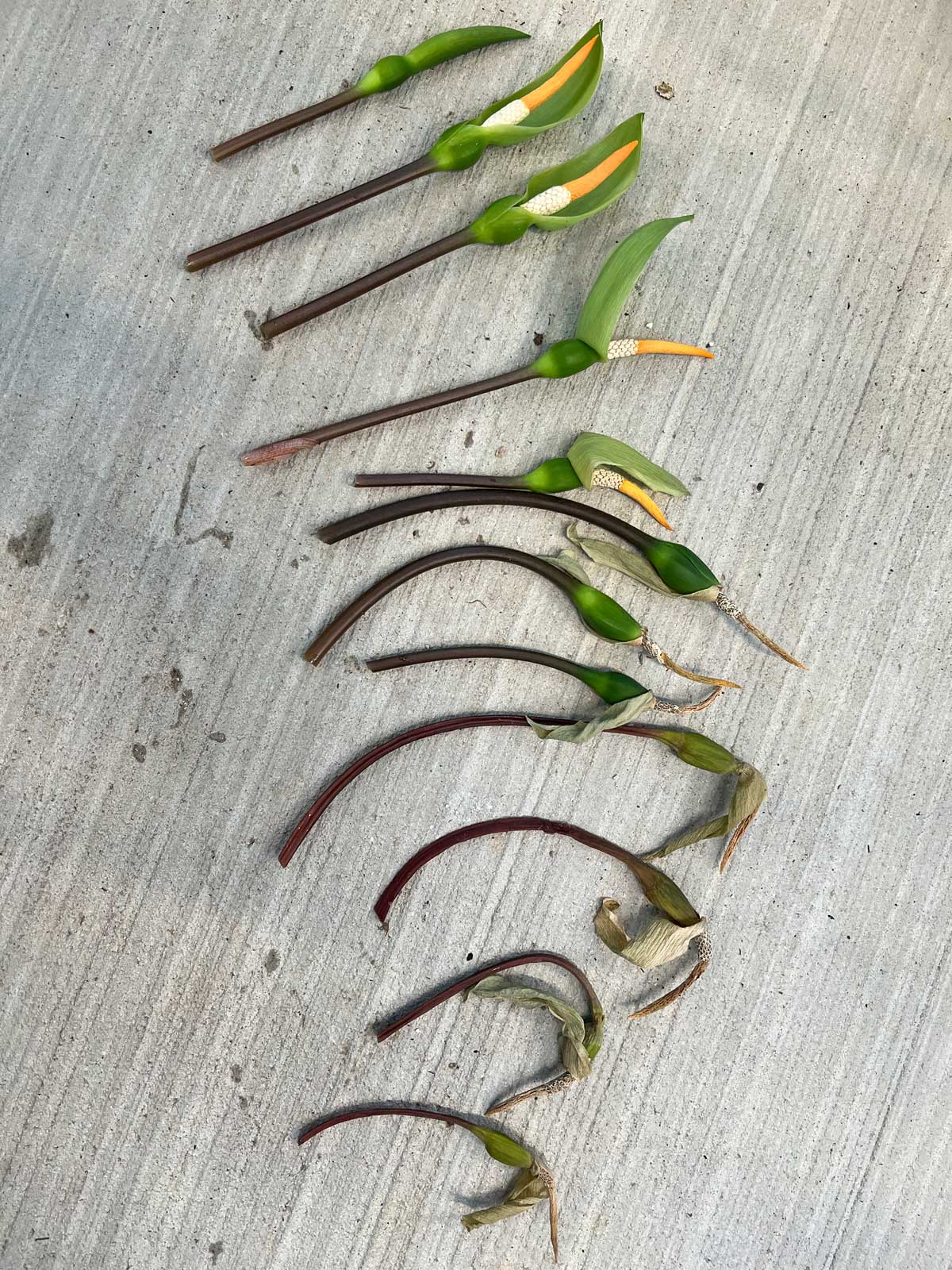
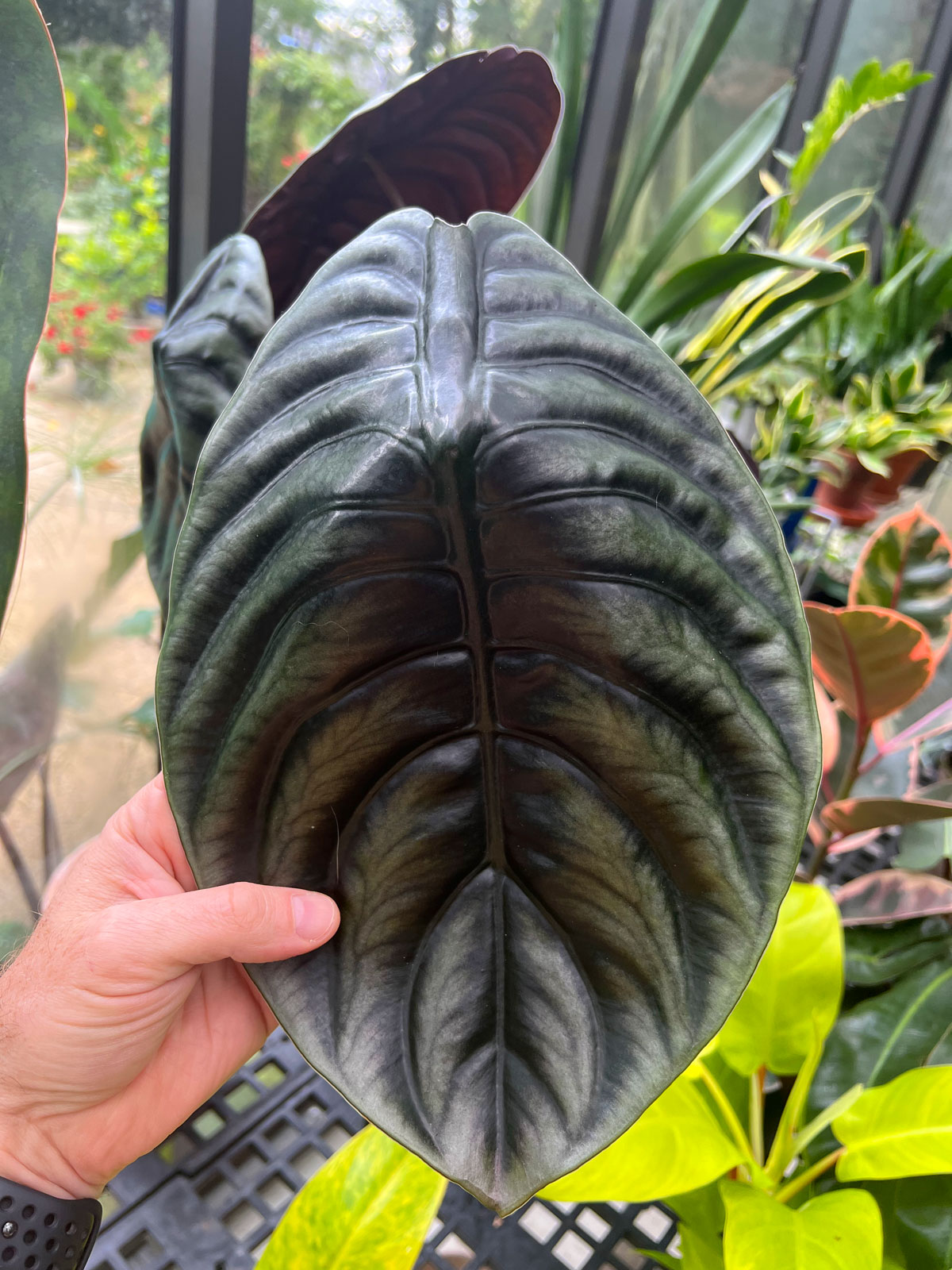
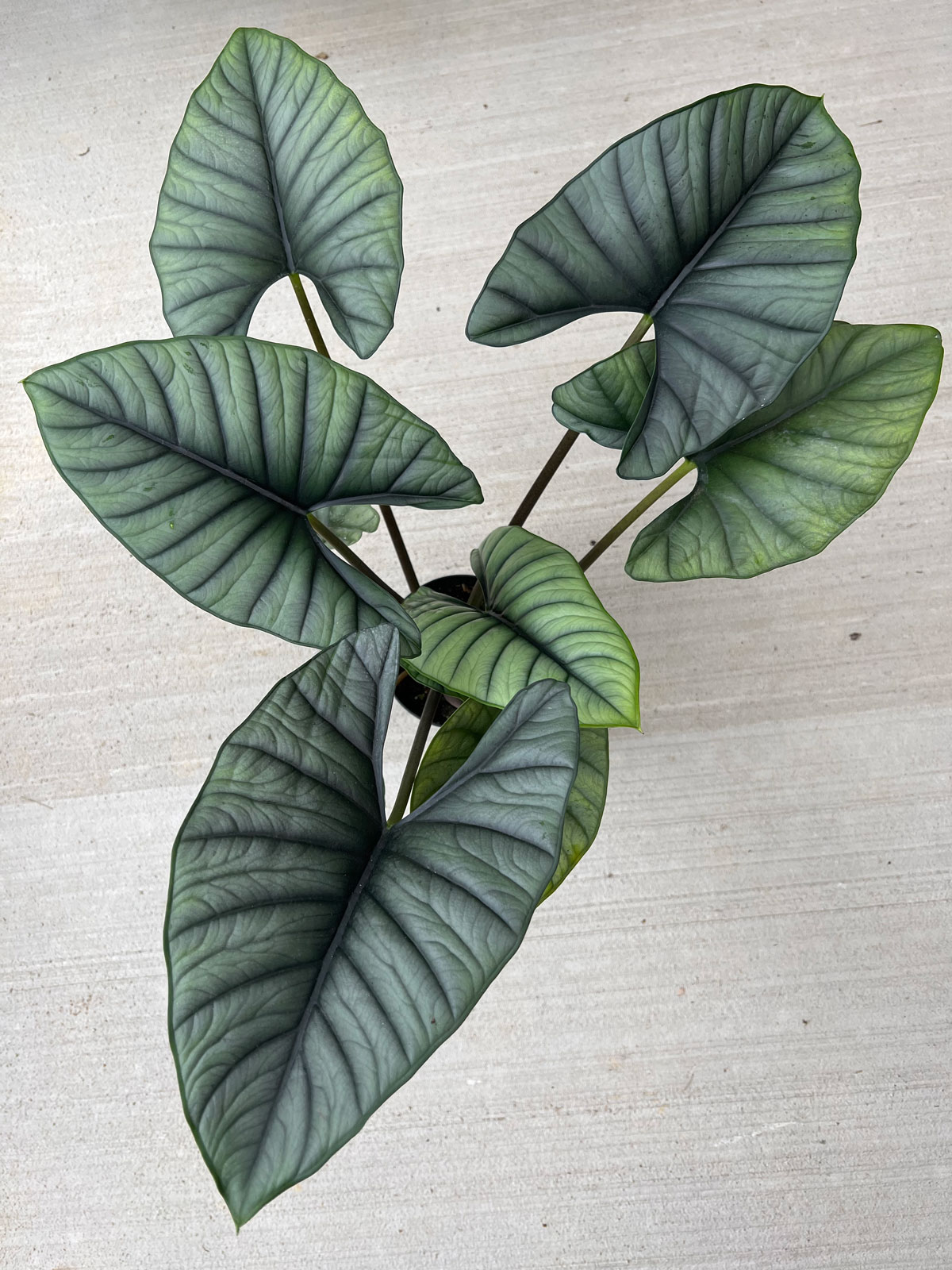
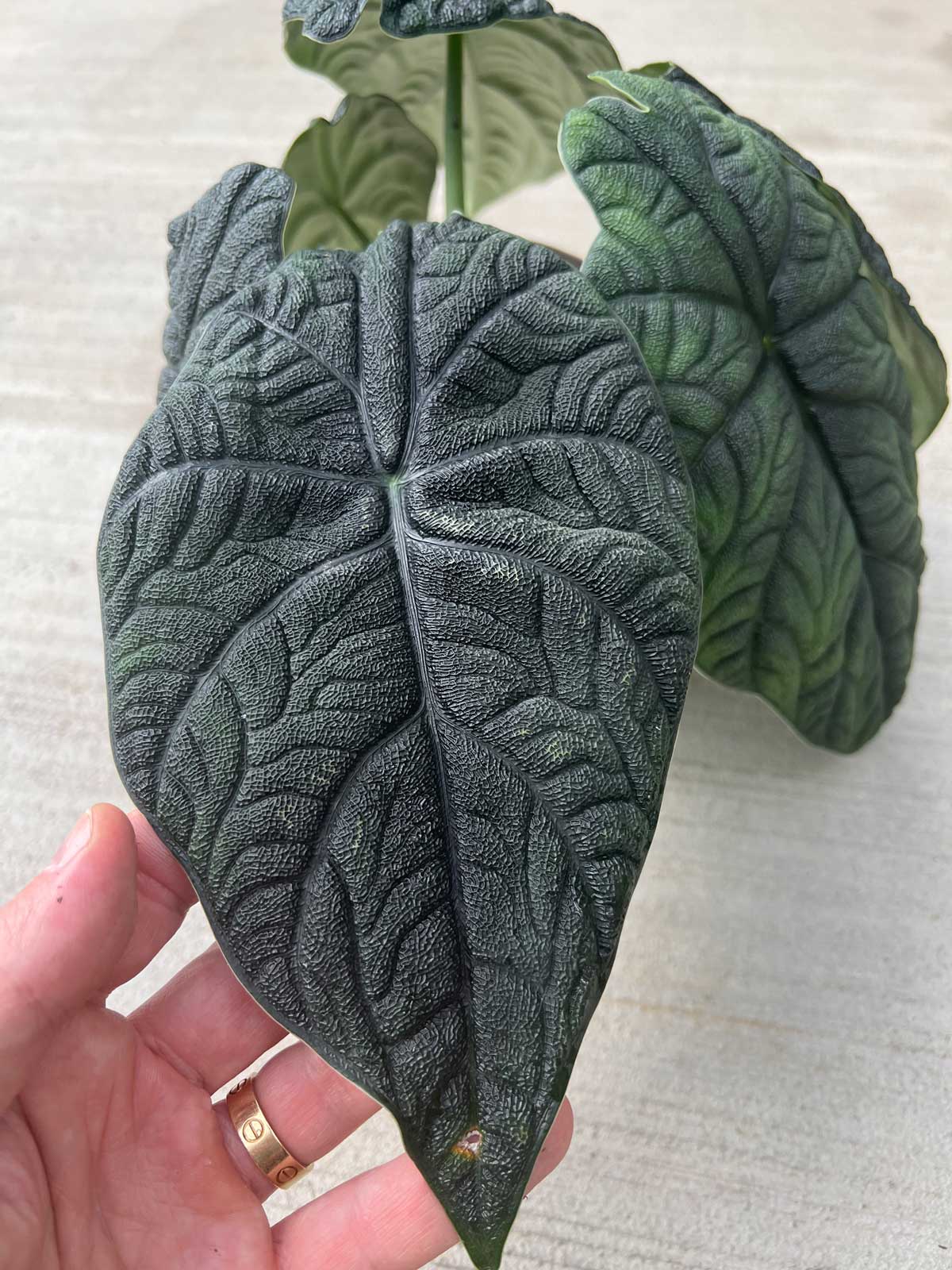
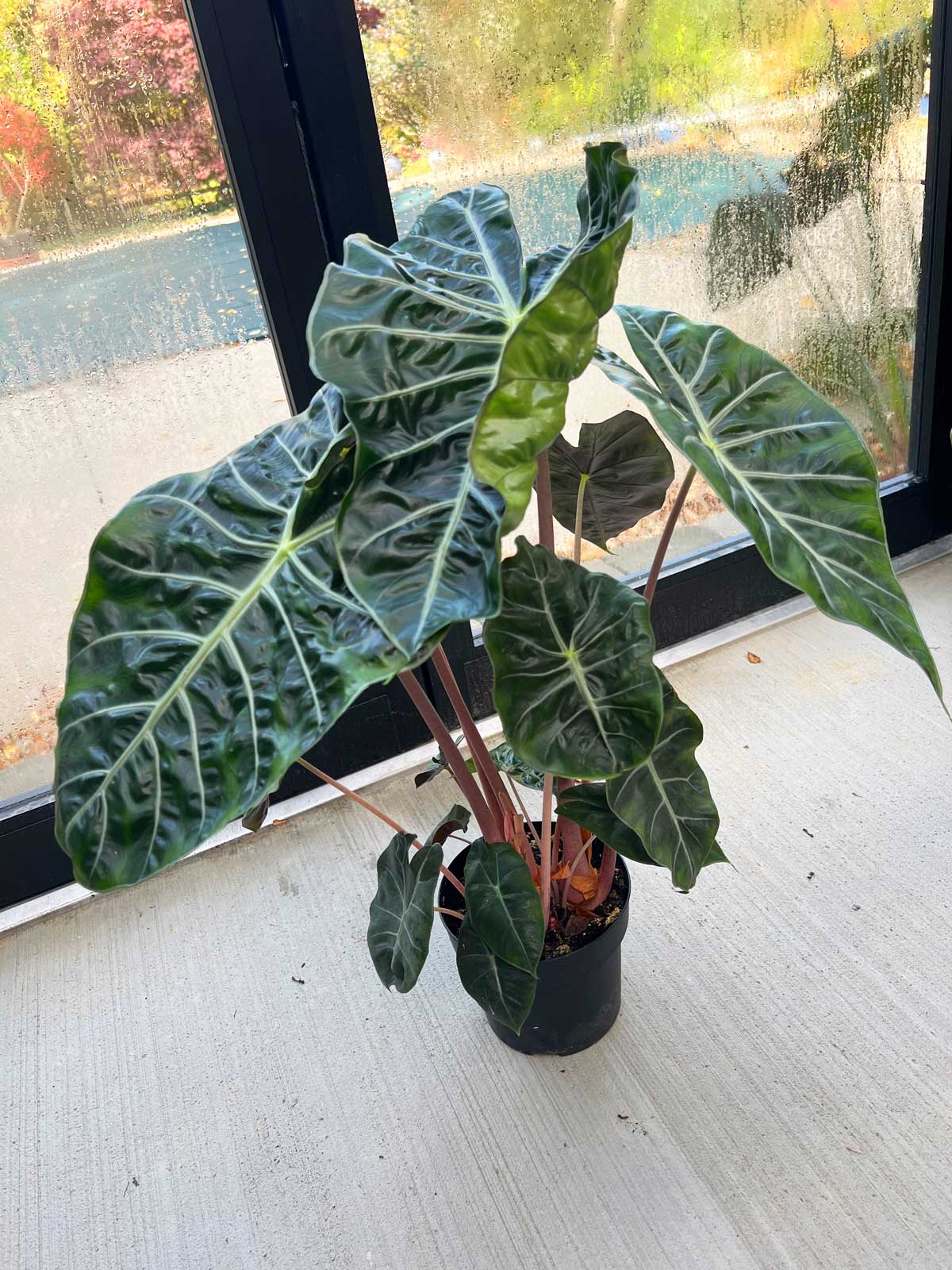
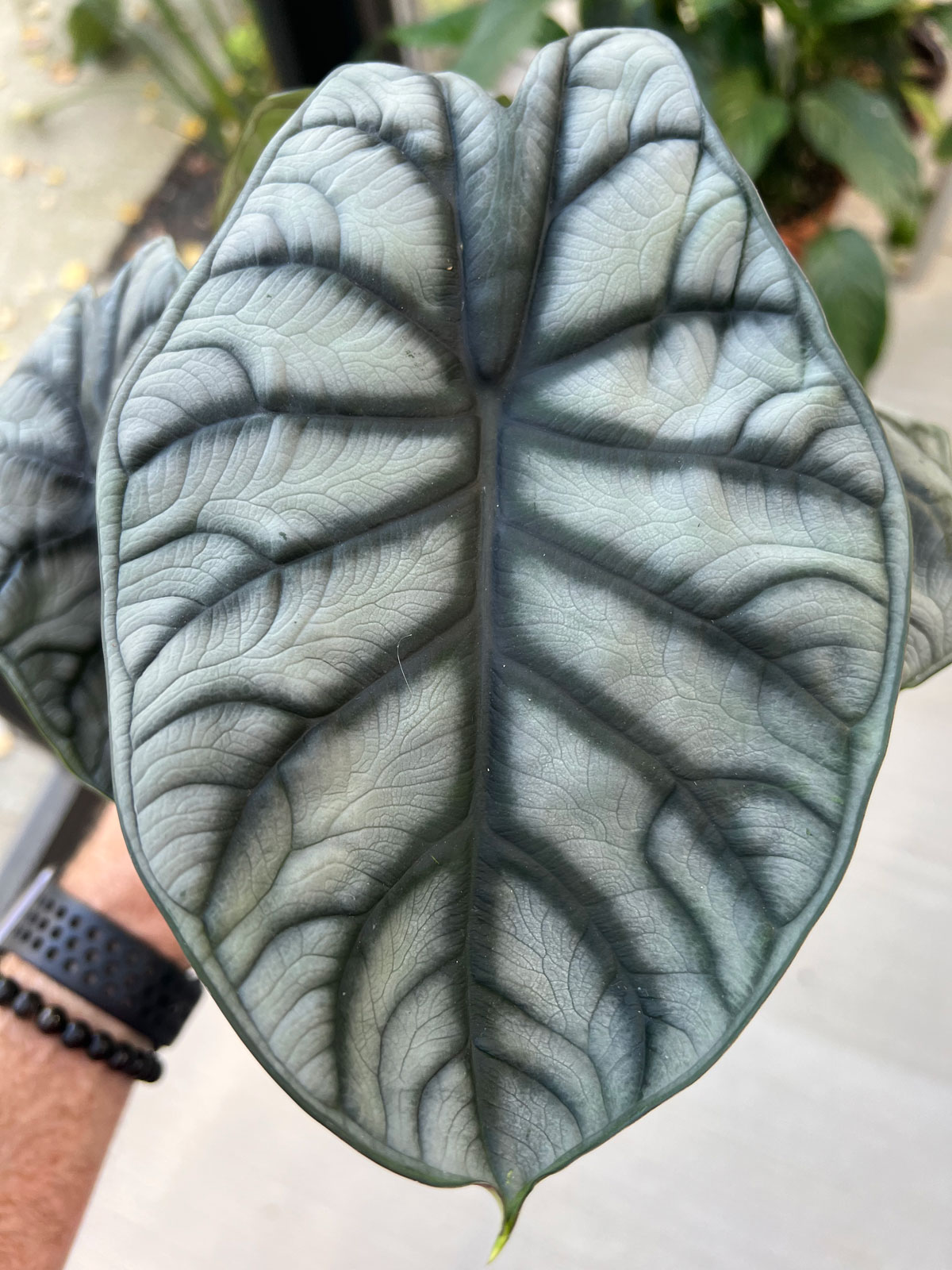
Sarah
Saturday 6th of January 2024
Great information. I would like to follow you, as I have quit a few different variety.
Raffaele
Saturday 6th of January 2024
Glad you enjoyed!